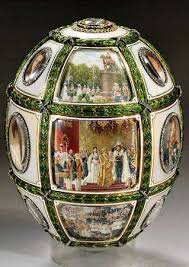Legacies of A Lost Empire
By Jen Talaver
@hoshi18 (3)
Zamboanga City, Philippines
August 9, 2014 9:47am CST
Age by age
Time flies so quickly
Era upon era
Families start and end
Page after page
The book closes
And only the story remains.
Fabergé’s Eggs: The Royal Russian Easter Tradition
As Easter was regarded the most important occasion of the year in the Russian Orthodox Church, just the same honor as Christmas in the Roman Catholic Church, it brought about a custom of bringing hand-coloured eggs to Church to be blessed and then presented to friends and family – in the nobility, jewel-encrusted eggs are exchanged as a sign of wealth and power. Fabergé was indeed a privileged artist when he was commisioned by Tsar Alexander III to design a jewelled Easter egg as his surprise gift to his wife Empress Marie Fedorovna, in 1885, for the 20th anniversary of their betrothal. The Tsar himself was involved in the design and execution of the egg, making sure that everything was perfect for his beloved wife.
The first Fabergé Egg was the Hen Egg, crafted from gold, its opaque white enamelled ‘shell’ opening to reveal its first surprise, a matt yellow gold yolk. Magnificently, this opens to reveal a multi-coloured, superbly chased gold hen that also opens. So great was the Empress’ joy and marvel at the Tsar’s special gift that she had made it a yearly Imperial tradition for the Romanov family to exchange gifts of the most fascinating Easter eggs the world has ever seen. The Tsars presented the wifes the Empresses each year with this Easter gift – not only doing so when the Russo-Japanese War happened between the years 1904 and 1905.
Loyal yet creative in his designs, Fabergé derived them from the family ties, events in Imperial Court life, or the milestones and achievements of the Romanov dynasty – for instance, the Fifteenth Anniversary Egg of 1911, commemorating the fifteenth anniversary of Nicholas II’s accession to the throne, and the Romanov Tercentenary Egg of 1913 that celebrated 300 years of the House of Romanov, showing portrait miniatures of the Russian dynastic rulers.
Of the 50 exquisite eggs Fabergé had created for the Imperial Romanov family from 1885 through to 1916, 42 have survived from the fall of the Tsar’s dynasty and are currently one of the most sought-after treasures in the market. Most are kept in St. Petersburg, in remembrance of the last monarchial family who ruled in Russia.
Silent Witness to the Fall
This series of lavish Easter eggs designed specifically for the Russian Imperial family - between 1885 and 1916 - is regarded as the artist-goldsmith’s greatest and most enduring achievement. The legend that has become the most celebrated inspired awe among all works of art – even more than the Jewels of The Tower of London – is largely a part of history: entangled in a dynasty that has been the best from the start yet had fallen apart in the worst moment of the history of royal Russia.
Author and Fabergé expert, Géza von Habsburg deemed Fabergé eggs as the msot exquisite work of the art – the ultimate masterpieces of the artist-goldsmith. "They are the absolute summit of craftsmanship. They are unbelievably made. They were the sort of apogee of what Fabergé was able to do, and he lavished everything he could on them." A labor of love by a most dedicated artist to a family he very well respected and esteemed was a most fitting memory of him to them. However, though this may not have been Fabergé’s intention, these eggs became painful reminders of the tragic events that happened to the Russian monarchial family as they were objects handed in tradition from generation to generation of Romanovs.
The most painstaking in articulate memory and keen details of all Fabergé’s creations was the Fifteenth Anniversary egg (1911), a family album just over five-inches-tall. The artist had painted exquisitely detailed the most notable events of the reign of Nicholas II and each of the family members. The artist Fabergé never expected his creation to be a omen of misfortune for it is the one most intimately associated with the whole tragedy of Nicholas and Alexandra and their incredibly beautiful family. The five royal siblings had been depicted in all the glamor of their noble life – smiling and looking truly happy at anyone who gazes upon the egg, little do they know that their lives will be most painfully ended by the next few years after the egg was made.
In 1917, the Czar Nicholas II was charged with mismanaging the Russian empire and he was arrested with all other members of the Romanov family. Cold was the day when it dawned in July 17, 1918 the former Russian ruler Nicholas and Alexandra, with their five children – Olga, Tatiana, Maria, Anastasia and Alexei – were herded into a basement and executed. The assasins did not even have the heart for the youngest one, Princess Anastasia who was only an eleven-year-old girl then. Only the Dowager Empress Maria Fedorovna escaped the assasination as she fled to her homeland, bringing in her arms the Order of St. George egg, the last Fabergé Imperial Easter egg her son Nicholas, the last Czar of Russia will ever gift her.
Exquisite masterpieces were they, but even as people look at them in marvel today, Fabergé’s Eggs will be always regarded as the silent witnesses to the fall of Russia’s last imperial dynasty. They are fittingly the legacies of a lost empire, for they embody the memories in the world of the once powerful Romanov family.
No responses





